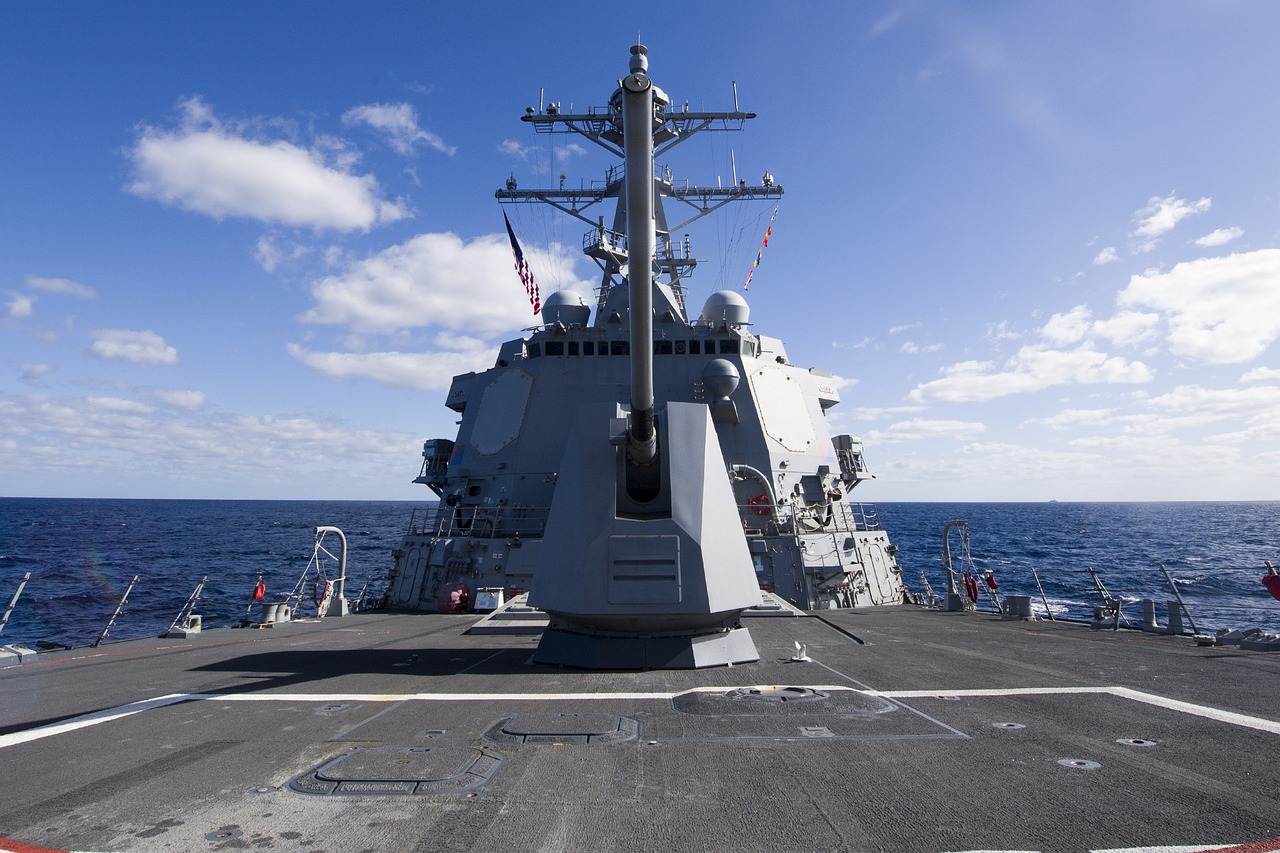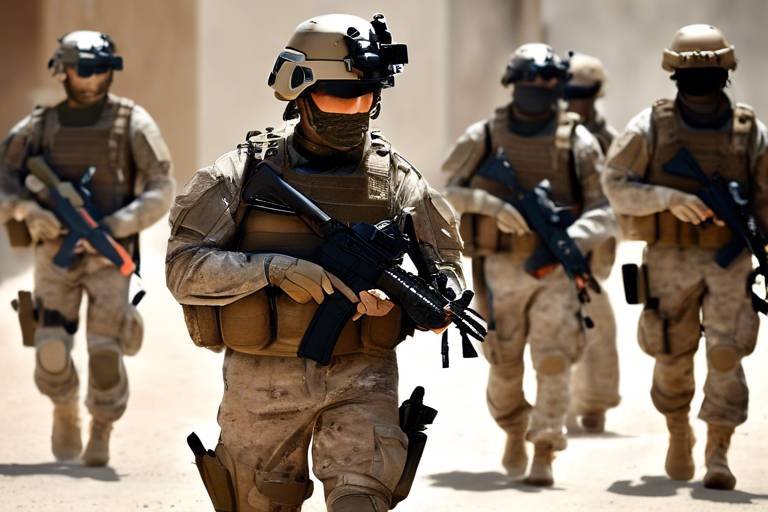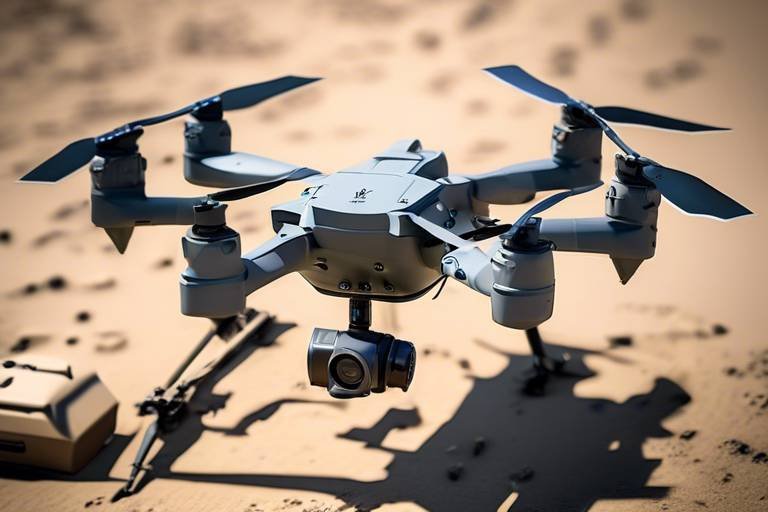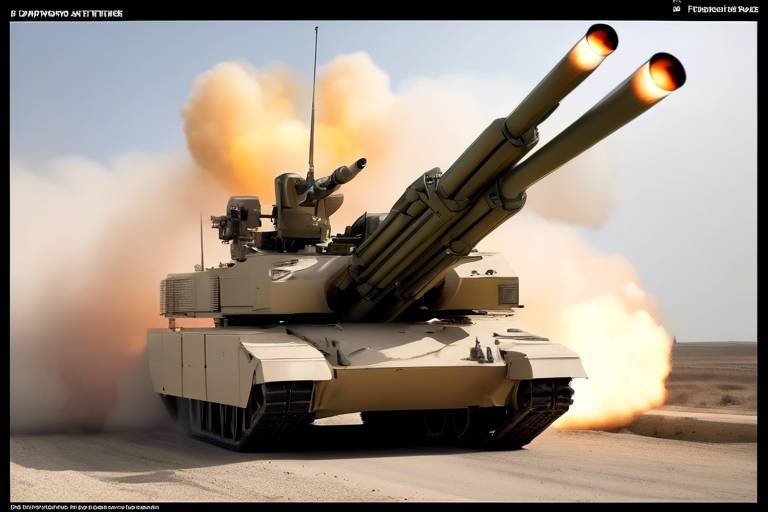AI in Naval Minesweeping - Defending Critical Sea Lanes
In today's world, where global trade and maritime security are more critical than ever, the role of artificial intelligence (AI) in naval minesweeping operations cannot be overstated. As nations strive to protect their vital sea routes from the ever-present threat of naval mines, AI emerges as a transformative force that enhances operational efficiency and safety. Imagine a scenario where ships can navigate through potentially dangerous waters with the confidence that AI-driven systems are detecting and neutralizing threats in real-time. This is not just a futuristic dream; it is becoming a reality.
Naval mines, often hidden and difficult to detect, pose significant risks to commercial and military vessels alike. The integration of AI into minesweeping operations is revolutionizing the way navies approach this challenge. By leveraging advanced algorithms and machine learning techniques, naval forces can analyze vast amounts of data to identify mine patterns, predict their behavior, and execute precise countermeasures. This not only saves time but also minimizes the risks to human life and naval assets.
Moreover, the implementation of AI technologies in minesweeping is not merely about replacing human operators but rather augmenting their capabilities. Picture a team of skilled personnel working alongside AI systems that enhance their decision-making processes and situational awareness. This collaboration leads to more informed choices and a greater chance of success in complex maritime environments.
As we delve deeper into this topic, it is essential to understand the various types of naval mines and the specific threats they pose. From contact mines that detonate upon physical impact to influence mines that react to changes in water pressure or magnetic fields, each type presents unique challenges. Addressing these challenges with AI-driven strategies is crucial for ensuring safe passage for naval vessels.
In the following sections, we will explore the specific AI technologies being utilized in minesweeping, examine real-world case studies of successful AI implementation, and discuss the challenges that come with integrating these advanced systems into naval operations. Additionally, we will look at the future trends in AI and maritime security, the importance of international cooperation, and the ethical considerations that arise from using AI in warfare.
- What are naval mines? Naval mines are explosive devices placed in water to damage or destroy ships or submarines.
- How does AI enhance minesweeping operations? AI improves detection, classification, and neutralization of mines, leading to safer and more efficient operations.
- What types of AI technologies are used in naval minesweeping? Technologies such as machine learning, computer vision, and robotics are commonly used.
- What challenges exist in integrating AI into naval operations? Challenges include data quality, interoperability, and the need for skilled personnel.
- Why is international cooperation important in minesweeping? It fosters information sharing, joint training, and standardized protocols, enhancing overall effectiveness.

The Role of AI in Modern Naval Operations
Artificial Intelligence (AI) is not just a buzzword; it's a game changer in the realm of naval operations. Imagine a world where decisions are made with lightning speed, where complex tasks are automated, and where the safety of our naval forces is enhanced through technology. That's the reality we're stepping into with AI in naval minesweeping. This technology is revolutionizing how naval forces operate, particularly in the challenging task of minesweeping, which has traditionally been fraught with danger and uncertainty.
One of the most significant contributions of AI is its ability to enhance decision-making processes. In the past, naval personnel had to rely on their instincts and experience to navigate through mine-infested waters. However, with AI, data from various sources can be analyzed in real-time, allowing for informed decisions that can save lives and resources. For instance, AI algorithms can process vast amounts of data from sonar systems, satellite imagery, and even social media feeds to predict potential threats. This capability not only improves situational awareness but also allows for proactive measures rather than reactive ones.
Additionally, AI is automating complex tasks that were once labor-intensive and time-consuming. Think about the intricate procedures involved in detecting and neutralizing underwater mines. With AI-driven robotics and machine learning algorithms, these tasks can be performed more efficiently and accurately. For example, autonomous underwater vehicles (AUVs) equipped with AI can navigate through challenging environments, detect mines, and even neutralize them without putting human lives at risk. This automation not only accelerates the process but also mitigates the risks associated with human error.
Furthermore, AI enhances the safety of minesweeping missions. By utilizing advanced algorithms, naval forces can simulate various scenarios, allowing them to train and prepare for different outcomes without the inherent risks of live operations. This simulation capability is invaluable, as it equips personnel with the skills and knowledge necessary to handle real-world situations effectively. The integration of AI into training programs ensures that naval forces are not only prepared but also confident in their ability to tackle the challenges of modern warfare.
To put it succinctly, the role of AI in modern naval operations is multifaceted and transformative. It streamlines processes, enhances decision-making, and ultimately improves the safety and effectiveness of naval missions. As we continue to explore the vast potential of AI, it's clear that this technology will be at the forefront of naval operations, shaping the future of maritime security.
Frequently Asked Questions
- What is the primary benefit of AI in naval minesweeping?
The primary benefit is enhanced decision-making and improved situational awareness, allowing for faster and safer operations.
- How does AI improve the efficiency of minesweeping?
AI automates complex tasks and processes large amounts of data quickly, reducing the time and risk associated with traditional methods.
- Are there any risks associated with using AI in naval operations?
Yes, there are concerns regarding data quality, potential for errors, and ethical considerations in automated decision-making.

Types of Naval Mines and Their Threats
When we think about naval mines, the first image that often comes to mind is a hidden danger lurking beneath the waves, waiting to disrupt maritime operations. Indeed, naval mines are one of the oldest forms of naval warfare, and their evolution has brought about various types, each posing unique threats to both military and commercial vessels. Understanding these types is crucial in developing effective strategies for detection and neutralization, especially with the integration of advanced technologies like AI.
There are primarily two categories of naval mines: contact mines and influence mines. Contact mines are designed to detonate upon physical contact with a vessel. They can be deployed in shallow waters and are often camouflaged to blend with the seabed, making them particularly challenging to detect. On the other hand, influence mines are more sophisticated; they detonate based on the physical characteristics of a ship, such as its magnetic field, pressure, or acoustic signals. This means that even a ship that is careful not to physically touch a mine could still trigger an explosion.
| Type of Mine | Description | Threat Level |
|---|---|---|
| Contact Mines | Detonate upon physical contact with a vessel. | High |
| Influence Mines | Detonate based on the physical characteristics of a ship. | Very High |
| Smart Mines | Utilize advanced technology to adapt to environmental conditions. | Critical |
Another emerging threat is the development of smart mines, which leverage modern technology to enhance their effectiveness. These mines can adapt to environmental conditions and can be programmed to differentiate between friendly and enemy vessels. This adaptability makes them particularly dangerous, as they can remain dormant for long periods and reactivate when conditions are favorable for an attack.
Moreover, the proliferation of naval mines in conflict zones can severely disrupt shipping lanes, which are vital for global trade. The potential for civilian casualties and economic disruption is significant, especially in busy maritime routes. A minefield can create a no-go zone, forcing ships to reroute, which increases transit times and costs.
The threat posed by naval mines is not just limited to military operations. For instance, commercial shipping vessels are also at risk, as they often navigate through waters that may be mined. This situation necessitates a robust response mechanism, which is where AI-driven technologies come into play. By improving detection capabilities and enabling quicker responses, AI can help mitigate the risks associated with these deadly underwater devices.
In conclusion, understanding the types of naval mines and their respective threats is essential for enhancing maritime security. As we delve deeper into the realm of AI in naval minesweeping, it becomes clear that the integration of advanced technologies is crucial for effective detection and neutralization of these underwater hazards.
- What are the primary types of naval mines? The primary types are contact mines and influence mines, with smart mines being an emerging category.
- How do naval mines pose a threat to commercial shipping? Naval mines can disrupt shipping lanes, leading to economic losses and increased risks to civilian vessels.
- What role does AI play in dealing with naval mines? AI enhances detection, classification, and neutralization efforts, making minesweeping operations more efficient and safer.

AI Technologies Used in Minesweeping
In the ever-evolving landscape of naval warfare, artificial intelligence (AI) has emerged as a game-changer, particularly in the realm of minesweeping. The integration of AI technologies into minesweeping operations not only enhances the efficiency and safety of these missions but also significantly reduces the risks faced by naval personnel. Let's dive into some of the key AI technologies that are reshaping the way we approach the detection and neutralization of naval mines.
One of the most significant advancements in this field is the application of machine learning. By analyzing vast amounts of data from previous minesweeping missions, machine learning algorithms can identify patterns and improve detection capabilities over time. This means that as more data is fed into the system, its predictive accuracy increases, allowing for quicker and more effective responses to potential threats. Imagine having a system that learns from each encounter, becoming smarter and more efficient with every operation—this is the power of machine learning in action.
Another crucial technology is computer vision, which enables machines to interpret and understand visual information from the environment. In the context of minesweeping, computer vision can be used to analyze sonar images and underwater video feeds to identify mines. By employing advanced image recognition techniques, AI systems can differentiate between harmless objects and actual mines, drastically reducing the chances of false positives. This capability is akin to giving a computer eyes, allowing it to see and understand the underwater battlefield like never before.
Furthermore, the use of robotics in minesweeping operations has gained traction over the years. Autonomous underwater vehicles (AUVs) equipped with AI technologies can navigate complex underwater terrains, conduct surveys, and even neutralize mines without putting human lives at risk. These robots are designed to operate in challenging conditions, often in environments that are too dangerous for human divers. The combination of AI with robotics creates a powerful duo that enhances operational capabilities while ensuring safety.
To illustrate the impact of these technologies, let’s take a look at the following table that summarizes the key AI technologies used in minesweeping:
| AI Technology | Description | Benefits |
|---|---|---|
| Machine Learning | Analyzes data to improve detection capabilities. | Increased predictive accuracy and efficiency. |
| Computer Vision | Interprets visual data to identify mines. | Reduces false positives and enhances threat assessment. |
| Robotics | Utilizes autonomous vehicles for minesweeping. | Ensures safety and operational efficiency in hazardous environments. |
As we look to the future, the integration of these AI technologies will continue to evolve, paving the way for more sophisticated and effective minesweeping operations. The combination of machine learning, computer vision, and robotics not only enhances the capabilities of naval forces but also represents a significant leap towards safer maritime operations. With these advancements, we can better ensure the safety of critical sea lanes, making the oceans a little less perilous for all who traverse them.
- What is the primary role of AI in naval minesweeping?
AI enhances decision-making, improves detection capabilities, and automates complex tasks, making minesweeping operations more efficient and safer. - How does machine learning improve minesweeping operations?
Machine learning analyzes historical data to identify patterns, which increases predictive accuracy and helps in quicker threat responses. - What are autonomous underwater vehicles (AUVs)?
AUVs are robotic systems designed to operate underwater, capable of conducting surveys and neutralizing mines without human intervention. - What challenges exist in integrating AI into minesweeping?
Challenges include data quality, interoperability of systems, and the need for skilled personnel to operate advanced technologies.

Case Studies of AI Implementation
As we dive into the fascinating realm of AI in naval minesweeping, it’s essential to look at real-world examples where this cutting-edge technology has made a significant impact. One of the most notable case studies comes from the United States Navy, which has been at the forefront of integrating AI into its maritime operations. In a recent operation, the Navy employed AI-driven unmanned underwater vehicles (UUVs) to detect and neutralize naval mines in contested waters. These UUVs utilized advanced machine learning algorithms to identify patterns in sonar data, significantly reducing the time and manpower required for traditional minesweeping methods.
Another compelling example can be found in the collaboration between NATO and various tech companies. This partnership has led to the development of AI systems capable of performing real-time analysis of underwater environments. During joint exercises in the Mediterranean, these systems successfully identified and classified multiple types of naval mines, showcasing their ability to enhance situation awareness and operational efficiency. The integration of AI not only improved the speed of detection but also increased the safety of personnel involved in these high-stakes missions.
Moreover, the Royal Navy has also embarked on AI initiatives, focusing on predictive analytics to forecast potential mine threats based on historical data. By analyzing previous mine incidents, AI algorithms can predict where mines are likely to be laid, allowing for preemptive measures and strategic planning. This proactive approach has been instrumental in ensuring the safety of naval vessels traversing critical sea lanes.
To illustrate the impact of AI in these case studies, consider the following table that summarizes key outcomes:
| Case Study | Technology Used | Key Outcomes |
|---|---|---|
| U.S. Navy UUV Operations | Machine Learning Algorithms | Reduced detection time, increased safety |
| NATO Joint Exercises | Real-Time Analysis Systems | Enhanced situational awareness, improved efficiency |
| Royal Navy Predictive Analytics | Predictive AI Algorithms | Proactive threat forecasting, strategic planning |
These case studies not only highlight the transformative potential of AI in naval minesweeping but also serve as a testament to the ongoing commitment of naval forces worldwide to enhance maritime security. As we continue to explore the capabilities of AI, it's clear that the future of naval operations will be heavily influenced by these technological advancements.
- What is the primary benefit of using AI in naval minesweeping?
AI enhances the efficiency and safety of minesweeping operations by improving detection rates and automating complex tasks. - How does AI improve decision-making in naval operations?
AI analyzes vast amounts of data quickly, providing actionable insights that help commanders make informed decisions in real-time. - Are there any ethical concerns with AI in military applications?
Yes, ethical considerations include accountability for AI decisions, the potential for unintended consequences, and the need for human oversight.

Challenges in Integrating AI into Naval Minesweeping
The integration of artificial intelligence (AI) into naval minesweeping is a game-changer, but it doesn't come without its fair share of challenges. One major hurdle is the issue of data quality. AI systems rely heavily on vast amounts of data to learn and make decisions. If the data fed into these systems is flawed, outdated, or incomplete, the AI's performance can suffer significantly. Imagine trying to navigate a ship through treacherous waters using a map that's missing key features—it's a recipe for disaster!
Another significant challenge is interoperability. In a world where different naval forces use varied technologies and systems, ensuring that AI tools can communicate effectively across platforms is crucial. This lack of standardization can lead to confusion during operations, where time is of the essence. Think of it like trying to coordinate a dance with partners who are all following different choreographies; it just doesn't work smoothly.
Moreover, there's the pressing need for skilled personnel to operate these sophisticated AI systems. While AI can automate many tasks, human oversight is still essential. Training naval personnel to understand and effectively use AI technologies requires significant investment in time and resources. The gap between technology and human capability can create a bottleneck in the adoption of AI in minesweeping operations.
Furthermore, the complexity of underwater environments poses a unique challenge. Mines can be deployed in various forms and locations, making detection and classification a daunting task. AI systems must be trained to recognize a wide range of mine types, which requires extensive and diverse datasets. If the AI is only trained on a limited set of scenarios, it may not perform well in real-world situations where conditions are unpredictable.
Lastly, ethical considerations surrounding the use of AI in warfare cannot be overlooked. The potential for unintended consequences—such as misidentifying a target or failing to recognize a civilian vessel—raises serious questions about accountability and decision-making in high-stakes environments. As we integrate AI into naval operations, we must navigate these ethical waters carefully to avoid compromising our moral obligations.
- What are the main challenges in integrating AI into naval minesweeping?
The main challenges include data quality, interoperability, the need for skilled personnel, the complexity of underwater environments, and ethical considerations.
- How does data quality affect AI performance?
AI systems require accurate and comprehensive data to learn effectively. Poor data quality can lead to inaccurate predictions and decisions, potentially jeopardizing missions.
- Why is interoperability important in naval operations?
Interoperability ensures that different naval forces can effectively communicate and coordinate during operations, which is crucial for mission success.
- What ethical concerns are associated with AI in warfare?
Ethical concerns include accountability for decisions made by AI systems, the potential for unintended consequences, and the moral implications of using AI in combat scenarios.

Future Trends in AI and Maritime Security
The future of artificial intelligence (AI) in naval minesweeping is not just bright; it’s positively glowing with potential. As we look ahead, several trends are emerging that promise to reshape the landscape of maritime security. One of the most exciting developments is the evolution of autonomous systems. Imagine unmanned vessels equipped with advanced AI algorithms that can navigate treacherous waters, identify threats, and even neutralize mines without human intervention. These systems will not only enhance operational efficiency but also significantly reduce the risk to human lives.
Furthermore, the integration of enhanced data analytics is set to revolutionize how naval forces approach minesweeping. With the ability to process vast amounts of data from various sources—such as satellite imagery, sonar readings, and historical incident reports—AI can provide actionable insights that lead to quicker and more informed decision-making. This means that naval commanders will have a clearer picture of the underwater environment, allowing them to respond swiftly to emerging threats.
Collaboration is another key trend that is gaining momentum. As naval forces around the world recognize the importance of sharing information and resources, we are likely to see increased joint operations that leverage AI technologies. For instance, countries may engage in joint training exercises where AI systems are tested in real-world scenarios, fostering a culture of cooperation and enhancing overall maritime security. This collaboration will also extend to the development of standardized protocols, ensuring that AI systems from different nations can work seamlessly together.
Moreover, the rise of machine learning will play a critical role in improving the accuracy of minesweeping operations. Through continuous learning and adaptation, AI systems will become better at distinguishing between different types of mines and other underwater debris. This capability will not only streamline the detection process but also minimize false positives, allowing naval forces to focus their efforts where they are truly needed.
However, as we embrace these advancements, it’s crucial to remain vigilant about the ethical considerations that come with AI in warfare. Questions surrounding accountability, decision-making, and the potential for unintended consequences must be addressed to ensure that these powerful technologies are used responsibly. As we craft the future of AI in naval minesweeping, balancing innovation with ethical responsibility will be paramount.
In summary, the future trends in AI and maritime security are poised to transform naval minesweeping operations. From autonomous systems and enhanced data analytics to international collaboration and ethical considerations, the landscape is evolving rapidly. As these trends unfold, they will not only enhance the effectiveness of minesweeping missions but also contribute significantly to the overall safety of critical sea lanes.
- What are autonomous systems in naval minesweeping?
Autonomous systems refer to unmanned vessels that utilize AI to navigate waters, detect threats, and neutralize mines without human intervention. - How does enhanced data analytics improve minesweeping?
Enhanced data analytics allows for the processing of large datasets to provide actionable insights, leading to quicker decision-making in identifying and responding to threats. - Why is international collaboration important in maritime security?
International collaboration fosters information sharing and joint training, which enhances the effectiveness of minesweeping operations and maritime security overall. - What ethical concerns are associated with AI in naval operations?
Ethical concerns include accountability, decision-making processes, and the potential for unintended consequences in warfare scenarios.

International Cooperation in Naval Minesweeping
In the ever-evolving landscape of maritime security, international cooperation in naval minesweeping has emerged as a critical component for ensuring the safety of global shipping routes. With the increasing complexity of naval mine threats, no single nation can tackle these challenges alone. Instead, nations are banding together, pooling their resources, expertise, and technology to create a more robust defense against underwater mines. This collaboration is akin to a well-coordinated dance, where each partner plays a unique role, yet moves in harmony to achieve a common goal.
One of the primary benefits of international cooperation is the sharing of intelligence and best practices. Countries that have faced similar threats can provide insights into effective minesweeping strategies, which can significantly enhance the capabilities of partner nations. For instance, during joint exercises, navies can test and refine their tactics in real-world scenarios, leading to improved operational readiness. These exercises often simulate various mine-laying techniques and countermeasures, allowing crews to practice and adapt to changing conditions.
Moreover, joint training initiatives foster a sense of camaraderie and unity among participating nations. This is particularly important in regions where maritime security is a shared concern. For example, the Mediterranean and the South China Sea are areas where multiple nations face similar threats. By working together, they can develop standardized protocols for minesweeping operations, which not only increases efficiency but also minimizes the risk of miscommunication during critical missions.
To illustrate the importance of international cooperation, consider the following table that outlines some key collaborative efforts in naval minesweeping:
| Initiative | Participating Countries | Objective |
|---|---|---|
| Joint Maritime Exercises | USA, UK, Canada, Australia | Enhance interoperability and tactical coordination in minesweeping operations. |
| Information Sharing Networks | NATO Member States | Facilitate real-time data exchange on mine threats and countermeasures. |
| Standardization of Equipment | European Union | Develop common technical standards for minesweeping technologies. |
However, while international cooperation offers numerous advantages, it is not without its challenges. Differences in operational procedures, varying levels of technological advancement, and political considerations can complicate collaborative efforts. Nations must navigate these hurdles with diplomacy and a shared commitment to maritime safety. Ultimately, the success of international cooperation in naval minesweeping hinges on the ability of nations to prioritize collective security over individual interests.
As we look to the future, the trend of international collaboration in naval minesweeping is likely to grow stronger. With emerging technologies such as autonomous systems and advanced data analytics, the potential for joint operations will expand, allowing for more effective responses to the threats posed by naval mines. In this interconnected world, the phrase "together we stand, divided we fall" resonates profoundly, especially in the context of protecting our vital sea lanes.
- Why is international cooperation important in naval minesweeping? International cooperation enhances the effectiveness of minesweeping operations by allowing nations to share intelligence, resources, and best practices.
- What are some examples of international initiatives in naval minesweeping? Examples include joint maritime exercises, information sharing networks among NATO member states, and the standardization of equipment within the European Union.
- What challenges do countries face when collaborating on minesweeping? Challenges include differences in operational procedures, varying technological capabilities, and political considerations that may affect cooperation.

Ethical Considerations of AI in Warfare
The integration of artificial intelligence (AI) into naval minesweeping operations brings forth a plethora of ethical considerations that cannot be overlooked. As we harness the power of technology to enhance our military capabilities, we must also grapple with the implications of these advancements on human life and decision-making. One of the most pressing concerns is the autonomy of AI systems in making life-and-death decisions. When a machine is tasked with identifying and neutralizing threats, who is accountable if it makes a mistake? This question looms large, as the potential for unintended consequences increases with the sophistication of AI technologies.
Another critical aspect is the transparency of AI algorithms. Many AI systems operate as "black boxes," where the decision-making process is not easily understood or interpretable by humans. This opacity can lead to a lack of accountability, as it becomes challenging to ascertain why a particular action was taken. In military operations, where the stakes are incredibly high, ensuring that AI systems can be audited and understood is essential. The inability to explain AI decisions can undermine trust among military personnel and the public alike, raising alarms about the ethical deployment of these technologies.
Moreover, the use of AI in warfare raises significant questions about human oversight. While AI can process vast amounts of data and identify patterns faster than any human, relying solely on machines to make critical decisions can diminish the role of human judgment. The balance between leveraging AI for efficiency and maintaining human control is delicate. A scenario where AI autonomously engages targets without human intervention could lead to catastrophic outcomes, including civilian casualties and escalation of conflicts.
In addition to operational concerns, there are broader societal implications to consider. The deployment of AI in military operations could lead to an arms race in autonomous weapons technology, prompting nations to prioritize speed and efficiency over ethical considerations. This militarization of AI could have long-lasting effects on global security and stability. As countries rush to develop advanced AI systems, the potential for misuse or accidental conflict increases, highlighting the urgent need for international norms and regulations governing the use of AI in warfare.
To navigate these complex ethical waters, several key principles should guide the development and deployment of AI in naval minesweeping and other military applications:
- Accountability: Establish clear lines of responsibility for AI-driven decisions.
- Transparency: Ensure AI algorithms are understandable and auditable.
- Human Oversight: Maintain human control over critical decision-making processes.
- International Cooperation: Develop global standards and agreements to regulate the use of AI in military operations.
In conclusion, while AI presents exciting opportunities for enhancing naval minesweeping capabilities, it is imperative to address the ethical considerations that accompany its use. By prioritizing accountability, transparency, and human oversight, we can harness the benefits of AI while minimizing the risks associated with its deployment in warfare.
- What are the main ethical concerns regarding AI in warfare?
The primary concerns include accountability for decisions made by AI, transparency of AI algorithms, the need for human oversight, and the potential for an arms race in autonomous weapons technology.
- How does AI impact decision-making in naval minesweeping?
AI enhances decision-making by processing large amounts of data quickly and accurately, but it also raises questions about the reliability and accountability of those decisions.
- What measures can be taken to ensure ethical AI use in military operations?
Establishing clear accountability, ensuring transparency, maintaining human oversight, and fostering international cooperation are critical measures to guide ethical AI use.

Conclusion: The Future of AI in Naval Minesweeping
As we look to the horizon of naval operations, the integration of artificial intelligence in minesweeping represents a pivotal shift in maritime security. The potential of AI to enhance the efficiency and effectiveness of minesweeping operations cannot be overstated. With the ability to analyze vast amounts of data in real-time, AI systems are poised to revolutionize how naval forces detect, classify, and neutralize underwater threats. Imagine a future where autonomous drones equipped with advanced machine learning algorithms can navigate treacherous waters, identifying mines with pinpoint accuracy while minimizing human risk. This is not just a dream; it is becoming a reality.
However, the journey towards fully integrating AI into naval minesweeping is fraught with challenges. Issues such as data quality, interoperability between systems, and the necessity for skilled personnel to manage these sophisticated technologies must be addressed. As we advance, it will be crucial for naval forces to invest in training and development, ensuring that the human element remains an integral part of the operational framework. After all, technology is only as effective as the people who wield it.
Moreover, the ethical implications of using AI in warfare cannot be ignored. Questions surrounding accountability, decision-making in life-and-death scenarios, and the potential for unintended consequences must be at the forefront of discussions among military leaders and policymakers. Establishing clear guidelines and ethical standards will be essential to navigate this complex landscape.
Looking ahead, we can anticipate exciting developments in AI technologies that will further bolster naval minesweeping capabilities. Innovations such as enhanced data analytics, improved collaboration between international naval forces, and the advancement of autonomous systems will shape the future of maritime security. By fostering a culture of cooperation and shared knowledge, nations can work together to ensure safer passage through critical sea lanes.
In conclusion, the future of AI in naval minesweeping is bright, filled with promise and potential. By embracing these technologies while addressing the inherent challenges, we can enhance our maritime defenses and protect vital sea routes for generations to come. The journey may be complex, but the rewards of a safer, more secure maritime environment are worth the effort.
- What is the role of AI in naval minesweeping? AI enhances decision-making, improves situational awareness, and automates complex tasks in minesweeping operations.
- What types of naval mines exist? There are several types, including contact mines, influence mines, and smart mines, each posing unique threats to naval vessels.
- What are the challenges of integrating AI into naval operations? Challenges include data quality, system interoperability, and the need for skilled personnel to operate advanced technologies.
- How can international cooperation improve minesweeping operations? Cooperation fosters information sharing, joint training exercises, and the development of standardized protocols.
- What ethical considerations arise from using AI in warfare? Ethical concerns include accountability, decision-making in high-stakes scenarios, and the potential for unintended consequences.
Frequently Asked Questions
- What is the role of AI in naval minesweeping?
AI plays a transformative role in naval minesweeping by enhancing decision-making processes, improving situational awareness, and automating complex tasks. This leads to increased efficiency and safety during minesweeping missions, allowing naval forces to operate more effectively in potentially hazardous environments.
- What types of naval mines exist, and why are they a threat?
There are several types of naval mines, including contact mines, influence mines, and drifting mines. Each type poses unique threats to naval vessels, as they can be triggered by physical contact or environmental changes. Understanding these mines is crucial for developing effective AI-driven strategies to neutralize them and ensure safe passage for ships.
- Which AI technologies are used in minesweeping?
AI technologies such as machine learning, computer vision, and robotics are integral to modern minesweeping. These technologies enhance the detection, classification, and neutralization of underwater threats, allowing for quicker and more accurate responses to potential dangers.
- Can you provide examples of AI implementation in naval minesweeping?
Yes! There are several real-world case studies where AI has been successfully implemented in naval minesweeping. These examples highlight the effectiveness of AI in identifying and neutralizing mines, showcasing the lessons learned and the improvements made in operational efficiency.
- What challenges does AI face in naval minesweeping?
Integrating AI into naval minesweeping comes with challenges such as ensuring data quality, achieving interoperability between different systems, and the need for skilled personnel to operate these sophisticated technologies. Addressing these challenges is essential for successful AI integration.
- What are the future trends for AI in maritime security?
The future of AI in naval minesweeping is promising, with advancements in autonomous systems, enhanced data analytics, and improved collaboration among naval forces. These trends are expected to shape maritime security strategies significantly, making operations more effective and safer.
- Why is international cooperation important in naval minesweeping?
International collaboration is crucial for effective minesweeping operations as it fosters information sharing, joint training exercises, and the development of standardized protocols. This cooperation enhances the capabilities of all involved nations, ensuring a more comprehensive approach to maritime security.
- What ethical considerations arise from using AI in warfare?
The use of AI in naval minesweeping raises important ethical questions, including issues related to decision-making, accountability, and the potential for unintended consequences in warfare scenarios. Addressing these ethical concerns is vital to ensure responsible use of AI in military applications.
- What does the future hold for AI in naval minesweeping?
The future of AI in naval minesweeping looks bright, with the potential for significant enhancements in capabilities. However, successful integration will require addressing technological, ethical, and operational challenges to fully realize AI's benefits in protecting critical sea lanes.



















